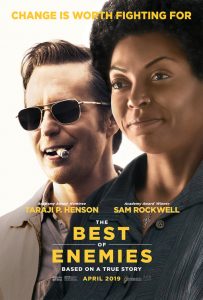A BIOGRAPHICAL account of how a Ku Klax Klan leader and a female black activist who ended up lifelong friends, The Best ofEnemies shares the historical racism engraved into the American socio-cultural environment.
Malaysians can take some lessons on shredding racism from our own societal fabric. from this movie which kicks off Sony Pictures’ Sony’s Reel Society five-movie offering in an exclusive partnership with GSC International Screens. The other movies include Late Night (Aug 1 opening), and Ode To Joy (Sept 19).
 The pivotal point of The Best of Enemies centres on the issue of school desegregation in North Carolina’s Durham town back in the 70s.
The pivotal point of The Best of Enemies centres on the issue of school desegregation in North Carolina’s Durham town back in the 70s.
An East Durham school for the black children is almost burnt and hence, the parents ask the town council for an alternative to allow the kids to finish their school year. The white folk don’t want to share their school.
The African-Americans are led in this appeal by ‘Roughhouse Annie” Atwater (played brilliantly by Taraji P. Henson of Hidden Figures and the TV series Empire fame).
She is known already to the council members as she runs Operation Breakthru, which seek solutions for the betterment of black lives in the town.
Atwater is a woman who bravely battles for her people. She has her facts ready, and has a cadre of workers at the office. A sterling class act at a time when white supremacy still reigns in all aspects of her life.
In the school issue, she gets unexpected help from the National Association of the Advancement of Coloured People. The appeal, which boils down to an integration of the public schools, lands on the desk of one of the town’s judges, and he wants to put off making a decision so that the white residents won’t vote against the town council chairman. Ahhh, politics never changes does it?
His assistant comes up with the idea of a charrette. Have you heard about a charrette before? Sounds like a wonderful idea. It is a conflict-resolution meeting, and used here to resolve the school integration issue.
The judge’s assistant calls a colleague, Bill Riddick (Babou Ceesay), who has had success organising charrettes in other communities.
Riddick turns up, and wants Atwater and the local KKK leader, C.P. Ellis (Sam Rockwell of Three Billboards Outside Ebbing, Missouri fame) to co-chair the meeting. It will run for 10 days, all day.
Ellis and Atwater share an office for those 10 days, and are forced to spend time together against their will. Even for lunch.
Atwater and Ellis learn much about each other, and how to work together in those 10 days.
The KKK people don’t seem to be concerned about the charrette’s outcome, as they are confident that Ellis – who just got awarded the Exalted Cyclops of the North Carolina Branch of the Ku Klux Klan – will do the right thing for the glory of the race.
Will the charrette work? It takes a lot of give and take.
Scenes of a KKK initiation, the Klansmen practising their marksmanship seemingly daily, the nightly meetings they hold, the single-minded purpose of the Klan youth cadre… and more are captured on the silver screen. Interestingly, these activities are shown as part of their normal, daily routine of life.
The charrette takes its toll on the town. There is subtle violence shown. School integration supporters are molested, their businesses get shut down, and threat lies heavy in the air of Durham.
While the movie fleshes out Ellis as a character you can sympathise with, it doesn’t give that much room to single mum Atwater. We don’t know why she is a single mum, what drove her to be such a fighter, a grassroots activist, and her back-story. That said, Henson has the accent, and the look down pat.
Director Robin Bissell in this directorial debut may have featured more on the Klan to perhaps sell the story which he adapted from the Osha Gray Davidson 1996 book “The Best of Enemies: Race and Redemption in the New South”.
This movie ends on a heart-lifting note, with a message of hope, optimism, and love.
The end credits reveal what happened to Ellis and Atwater. Their resolution to their lives is quite moving. The credits say Atwater, who herself died in 2016, gave the eulogy at Ellis’ funeral in 2005. Perhaps the inclusion of Vera Lynn’s 1939 song We’ll Meet Again has some deeper meaning in the movie then for the scene it was featured!
It is said that the cinema is for entertainment and not be believed. While Bissell has taken artistic licence with this cinematic account of the lives of Atwater and Ellis, you can leave with a sense of what real people can achieve… if they really want.
** This review appeared in the New Straits Times https://www.nst.com.my/lifestyle/groove/2019/07/501706/showbiz-uplifting-tale-hope-and-love-review

